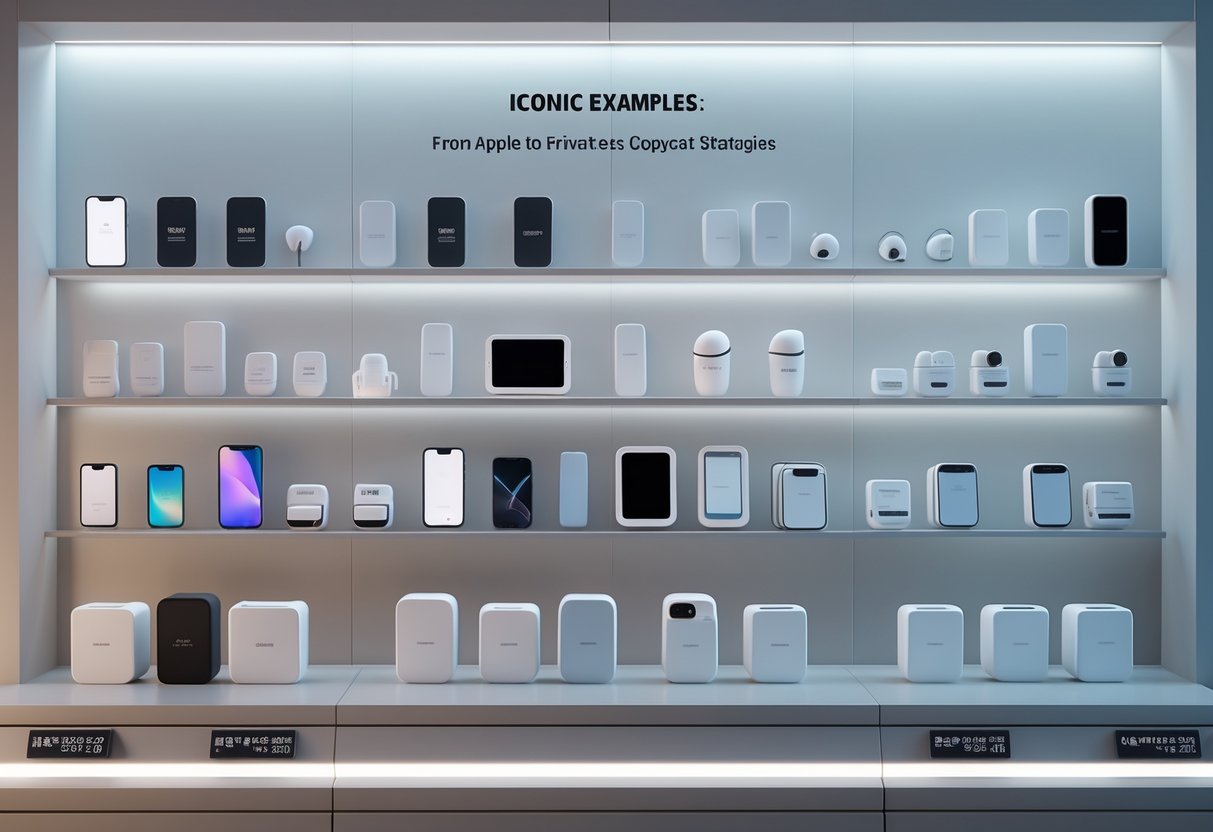Copycat Strategies: Winning with Smart Imitation and Innovation
Updated On: October 26, 2025 by Aaron Connolly
Understanding Copycat Strategies
Copycat strategies mean deliberately taking inspiration from what’s already working for your competitors or the big names in your field. Sometimes this looks like straight-up product copying, but more often, companies adapt business models that have already proven themselves somewhere else.
What Defines a Copycat Strategy?
A copycat strategy is pretty much what it sounds like: intentionally mimicking what’s already successful. Companies will copy products, marketing styles, or even entire business models if they see them working.
The real difference here is intentional imitation. Businesses don’t just stumble into similarity—they study the winners and try to recreate their playbook. That’s not the same as accidentally ending up with a similar idea.
Some common copycat moves:
- Copying product features and design
- Matching pricing structures
- Borrowing marketing messages
- Adopting customer service approaches
- Mirroring distribution methods
Copycat strategies only really work if you get why something’s a hit in the first place. Blind copying usually flops. The best imitators dig into the reasons behind a strategy’s success before jumping in.
A lot of big brands actually began by copying others. They learned the ropes from established players, then eventually found their own voice.
Types of Imitation in Business
You’ll find several flavors of business imitation out there. Each one comes with its own risks and rewards.
Direct copying is the most obvious—just making a carbon copy of a product or service. This route is risky, often lands you in legal hot water, and honestly, it rarely leads to long-term success.
Model adaptation means taking a proven business idea and tweaking it for a new place or market. Think of ride-sharing apps borrowing from taxis, or streaming services riffing off video rentals.
Cross-industry imitation is when a company borrows strategies from a completely different field. Fast-food-style efficiency now pops up in healthcare and retail, which is kind of wild when you think about it.
Feature borrowing is more subtle. Companies grab one or two good ideas from others but keep their own identity. You see this all the time with smartphone makers.
Process imitation is about copying what happens behind the scenes—like manufacturing tricks or management styles—instead of what the customer sees.
Common Motivations Behind Copycat Behaviour
So, why do companies copy? Turns out, there are a bunch of good reasons to go that route.
Risk reduction is huge. By copying what’s already working, companies dodge a lot of the uncertainty that comes with new ideas. It’s a safer bet.
Speed to market is another biggie. Original ideas take time and money. Copying lets you jump into hot markets way faster.
Learning acceleration helps newcomers get up to speed. Instead of reinventing the wheel, they watch and learn from the best.
Resource constraints make imitation attractive for smaller players. If you don’t have deep pockets, why not build on what’s already out there?
Market validation is a nice bonus. If someone else is making money with a certain approach, that’s proof there’s demand.
Competitive pressure means you sometimes have to copy just to keep up. If you ignore what your rivals are doing, you might get left behind.
Imitation versus Innovation
A lot of top gaming organizations don’t bother with brand new ideas. Instead, they win by copying smartly and moving fast—sometimes that’s way more effective than being the first to do something.
Debunking Innovation Myths
Everyone loves a good innovation story, but honestly, the numbers tell a different tale. Most hit esports games weren’t the first of their kind.
League of Legends borrowed heavily from Defense of the Ancients and just made it easier to play. Counter-Strike started as a mod. Fortnite took a lot from PUBG and added building.
Theodore Levitt once said, “imitation is not only more abundant than innovation, but actually a much more prevalent road to business growth and profits.” That’s spot on for gaming.
People think:
- The first mover always wins
- Copying is a losing move
- Innovation is a sure thing
- Imitation isn’t creative
But look at esports. Riot Games didn’t invent MOBAs—they just did them better. Activision Blizzard didn’t create new tournament formats from scratch; they just improved what was already there.
Innovation is risky. James Connolly, a gaming expert, points out that “most revolutionary gaming concepts fail because they ignore what players actually want.” Hard to argue with that.
The Value of Strategic Imitation
Copying smartly lowers your risk and gets you into the market faster. The savviest gaming companies study what works, then tweak it.
Copying can slash development costs by almost half compared to building something totally new. If a genre’s already popular, you know there’s an audience. Tournament organizers often copy event formats that already pull crowds.
Some clear upsides:
- Lower failure rates—proven ideas already have traction
- Faster launches—no need to explain everything to new users
- Smaller budgets—less money spent on R&D
- Clear benchmarks—you know what success looks like
ESL and DreamHack made it big by refining tournaments others started. Cloud9 and Team Liquid borrowed Korean training techniques instead of inventing their own.
But here’s the catch: if all you do is copy, you’ll always trail behind. The best companies pick and choose what to imitate, then add something unique.
Timing often beats originality. Fortnite took off because it launched when PUBG was struggling—not because battle royales were a new idea.
Combining Imitation and Innovation
The real winners mix imitation with smart innovation. They copy the basics, then find ways to stand out.
Riot Games borrowed MOBA mechanics, but they changed the game with:
- Visuals—brighter, more inviting art
- Business model—free-to-play, but with cool cosmetics
- Esports focus—built a competitive scene from day one
- Regional leagues—localized tournaments
This combo works because it keeps risk low but still lets them shine. If you only innovate, you might miss what people actually want. If you only imitate, you’ll blend in with the crowd.
Aaron Connolly, another gaming pro, sums it up: “The smartest esports companies copy what works and innovate only where they can add real value.”
Some good combo plays:
- Copy the basics, then make it look or feel different
- Borrow event formats, but add your own spin
- Use proven business models, but make the experience better
- Adopt standard practices, but out-execute everyone else
Twitch didn’t invent video streaming—they just made it for gamers. Discord didn’t invent voice chat, but they nailed what gaming communities needed.
It’s all about picking your spots instead of copying blindly or reinventing the wheel for no reason.
Evaluating the Pros and Cons of Copycat Approaches
Copycat strategies get you into the market fast, but they’re not without big risks. If you’re not careful, you can seriously hurt your brand’s reputation. It’s all about knowing when copying works—and when it just blows up in your face.
Short-Term Gains and Long-Term Viability
Copycat strategies can give you a quick boost by tapping into demand that’s already there. When you follow a successful competitor, you skip a lot of the heavy lifting and save on development.
Some quick wins:
- Lower marketing spend
- Customers already want what you’re selling
- Faster product launches
- Less chance of launching a dud
But these wins don’t stick around forever. Studies show copycats only really succeed when they stay close to the original’s market. If you stray too far, you lose any advantage.
Trouble starts when customers notice you’re just a copy. They’ll start comparing you to the real deal, and that can get awkward.
Heads-up: Lots of copycat businesses don’t make it past two years because they never build their own identity.
Risks of Copycat Strategies
Imitation can backfire in a big way. The biggest headache? Getting sued by the original brand for stealing their ideas.
Consumers lose trust when they spot obvious copying. Studies even show that when people compare copycats to the original, they usually think less of the imitator.
Major risks:
- Lawsuits and legal trouble
- Damaged brand reputation
- Customers get confused about what makes you special
- Hard to stand out from the crowd
- Little room for growth and new ideas
If everyone copies the same thing, nobody stands out. Customers get overwhelmed and can’t tell brands apart.
Pro tip: Pick one thing to do differently instead of copying everything.
The Impact on Brand Loyalty
Brand loyalty takes a real hit when customers realize you’re just copying someone else. Research says people pick up on the insincerity, and it turns them off.
This bad vibe makes it tough to build real, lasting relationships with your customers. People want to support brands that feel genuine—not just another knockoff.
Loyalty issues:
- Customers doubt you’re for real
- Harder to connect emotionally
- More people jump ship for something better
- Tough to build a real community
Sometimes, though, you can use copycat strategies and still build loyalty—if you actually improve on the original. It’s about making something better, not just making a clone.
Customers respect brands that take a good idea and actually make it better. That’s how you keep the perks of imitation while still building an authentic brand identity.
Types of Copycat Strategies in Practice

Companies usually pick from three main ways to copy the competition. Some go for brand imitation—mimicking logos or names. Others duplicate products. And some take it a step further, copying entire business models.
Brand Imitation
Brand imitation is all about copying the look, name, or vibe of a successful brand. You see it everywhere—from grocery store knockoffs to fashion.
Visual copying stands out the most. Store brands often use the same colors, fonts, and packaging as big-name products. Supermarkets love this tactic; just look at their cereal boxes next to Kellogg’s.
Name similarity is another trick. Companies pick names that sound like the leader, hoping shoppers will think they’re just as good. It works best in crowded markets where people make snap decisions.
Private labels might be the most “legit” form of brand imitation. Stores launch their own versions of top products, usually at a better price. Tesco’s store brands pull this off all the time.
Positioning mimicry is about copying how a brand presents itself. New players often use the same messaging and target the same crowd as the big guys.
The trick is staying close enough to the original to get noticed, but not so close that you get sued. Smart imitators walk that line.
Product Duplication
Product duplication is when a company makes something almost identical to a popular product. Success here depends on really understanding what makes the original tick.
Feature copying is the backbone. Companies break down the hit product and rebuild its main features. Samsung’s early smartphones, for example, looked and worked a lot like iPhones.
Manufacturing replication means producing a similar quality but at a lower price. Chinese factories got really good at this—they started by copying Western products, then eventually started innovating themselves.
Technology transfer speeds things up. Companies might hire talent from rivals or reverse-engineer products to figure out how they work.
Market timing is everything for product duplicators. If you move quickly, you can grab market share before the original gets too far ahead. Generic drug makers do this all the time when patents run out.
The real challenge? You’ve got to go beyond copying. The winners add something new, cut costs, or target a different audience than the original.
Business Model Replication
Business model replication means copying entire operational frameworks, not just products or brands. Companies often use this strategy to break into new markets.
Operational copying happens when companies take the way successful businesses run their processes and make it their own. Ryanair, for example, took Southwest Airlines’ low-cost model and brought it to European travelers.
Revenue model adoption lets companies borrow how others earn money. Streaming services piled onto Netflix’s subscription model instead of inventing new ways to monetize.
Customer experience replication is all about mimicking service delivery. Budget hotel chains, for instance, often borrow each other’s check-in routines, room setups, and pricing tricks.
Geographic arbitrage is another classic move. Companies spot a winning model in one region and launch it somewhere else. This works especially well if the original brand hasn’t gone global yet.
Supply chain copying shows up when companies mirror how top players handle logistics and partnerships. Retailers around the world have borrowed Walmart’s distribution playbook.
The best copycats don’t just clone—they tweak. Local culture, rules, and how mature a market is all force companies to adapt rather than just paste the original.
Iconic Examples: From Apple to Private Labels

Plenty of famous brands got their start by copying first, then finding their own twist. Private label brands do this all the time, offering cheaper alternatives that look a lot like the premium stuff.
Apple and Innovation by Imitation
Apple didn’t always lead the pack. In the early days, the company borrowed plenty from rivals before landing on its own signature style.
When Lexus hit the market in 1989, Toyota clearly borrowed Mercedes-Benz design cues. The LS 400 looked a lot like the Mercedes S-Class, inside and out. Toyota’s plan was straightforward: give people Mercedes luxury, but at a friendlier price.
Xiaomi ran a similar play with Apple. The Chinese tech company made its name by building products that looked and felt like Apple’s. Their phones had those rounded corners, and their stores looked eerily similar to Apple’s.
People started calling Xiaomi the “Apple of China.” Being far from Cupertino and with different intellectual property laws, Xiaomi grew huge while sticking to this formula.
It’s kind of funny—many of today’s so-called innovators started by copying the best, then carving out their own path.
The Private Labels Phenomenon
Private label brands take legal copying to a whole new level. Store brands crank out products that look and feel like name brands but stay just on the right side of the law.
Aldi has really nailed this game around the world. Their Nutoka hazelnut spread, for example, looks almost exactly like Nutella. Fonts, colors, and packaging across their products remind shoppers of the big brands.
Walmart’s Sam’s Choice line does the same thing. The cola comes in red cans that look a lot like Coca-Cola’s. Their cereals show off mascots that feel familiar, too.
| Brand | Copies | Strategy |
|---|---|---|
| Aldi | Nutella, major brands | Similar packaging, slight name tweaks |
| Sam’s Choice | Coca-Cola, cereals | Matching colors, familiar layouts |
| Trader Joe’s | Oreos, Stacy’s | Private labeling, lookalike products |
These brands make just enough changes to dodge trademark trouble. The result? Products that look familiar but cost less, stealing a slice of the premium brands’ market.
Lessons from Big-Name Copycats
Fast fashion proves that copying can be a whole business model. Zara built its empire by snatching up designer styles and getting them to stores at lightning speed. They basically turn runway ideas into retail gold.
Sometimes Zara even beats the original designers to the punch. From Celine bags to Louboutin shoes, they churn out hundreds of copies a year, and lawsuits rarely stick.
Forever 21 pushes this even further. Over 50 designers have hauled them into court for design theft, including big names like Diane von Furstenberg.
They just treat the occasional settlement as a business expense. Turns out, copycatting can pay off if the legal bills stay smaller than the profits.
It’s a blurry line between inspiration and theft. But with a few tweaks, strategic copying has become the norm—giving shoppers affordable choices and keeping original brands on their toes.
Navigating Challenges with Copycats
Protecting your brand from copycats means knowing your legal rights and keeping an eye out for threats. Staying alert helps you spot brand imitation before it chips away at your reputation.
Legal and Ethical Considerations
When you’re up against copycats, you’ve got to know what’s actually protected. Trademark law covers your brand name, logo, and slogan—but only if you register them.
Copyright protects creative stuff like your writing, designs, and videos. It won’t cover basic ideas or common phrases, though.
The tricky part? Proving someone crossed the line from “inspired by” to “stole it.” Using similar colors or layouts often isn’t illegal. Copying your actual tagline or logo? That’s a different story.
Reaching out directly usually works better than lawyering up. A lot of copycats don’t even know they’re causing issues and will adjust if you just ask.
If you need to escalate, gather evidence first. Screenshot everything, save links, and jot down dates. This stuff matters if you end up needing help.
Keep in mind, some copying is totally legal. Competitors can offer similar services or use industry lingo. The key is whether they’re trying to trick your customers.
Monitoring Your Brand’s Vulnerability
Set up alerts so you catch copycats fast. Google Alerts for your brand name, slogan, and unique phrases help with basic tracking.
Social media has built-in search tools. Check Instagram hashtags, Twitter mentions, and LinkedIn posts for unauthorized uses.
Tools like Mention or Brand24 dig deeper. They scan the web for your brand and ping you when they spot something.
Watch out for these red flags:
- Similar business names popping up nearby
- Website text or images that look ripped off
- Social media posts that mirror yours
- Fake accounts using your branding
Spend about half an hour each week searching for your brand online. Don’t stop at the first Google page—copycats often lurk deeper.
Your customers can be your best eyes and ears. They’ll spot fakes before you do and usually let you know.
Building Authenticity and Brand Loyalty

Authentic brands build emotional bonds that copycats just can’t fake. Loyal customers pick quality over knockoffs every time. Honest communication and real relationships help esports brands stay strong against imitators and grow loyal communities.
Cultivating a Genuine Brand Identity
Your brand story should feel honest if you want people to connect. We see top esports organizations sharing their beginnings, team struggles, and real wins with fans.
Start with your core values. Write down what really matters to your brand. Don’t just pick trendy ideas—think about what sets you apart.
Post behind-the-scenes content often. Show training, meetings, or honest chats about tough losses. Fans trust brands that aren’t afraid to be real.
Keep your tone steady everywhere. Your Twitter, YouTube, and website should all sound like you. If you mix it up too much, fans get confused and trust drops.
Look at Cloud9. They share player stories and team moments, not just highlight reels. Fans connect with those genuine glimpses behind the curtain.
Protecting Brand Trust Against Imitators
Imitators can hurt your reputation with low-quality products or services that look like yours. We keep brands safe through smart monitoring and proactive legal steps.
Check social media for fakes every day. Use Google alerts for your brand and common misspellings. Report imposters to the platforms right away.
Register trademarks early. This gives you legal power if someone copies your name or logo. Set aside £200-500 for UK trademark basics.
Build real relationships with your fans. When you’re present in comments, Discord chats, or at community events, fans spot fakes faster.
Use verification tools for official messages. Stick to the same email domains, get those social media checkmarks, and explain how fans can spot the real you.
Community-Building for Loyalty
Strong communities naturally defend authentic brands. We build these ties through regular engagement and experiences that matter to fans.
Host events that go beyond tournaments. Run monthly Q&As, charity streams, or game nights. These moments help fans feel connected.
Reward loyal fans with special perks. Give out early tickets, exclusive content, or direct chats with players. Make your supporters feel valued.
Listen and respond to feedback. When fans bring up issues or ideas, answer honestly and quickly. It shows you care about their experience, not just their cash.
Create spaces where fans bond with each other, not just you. Discord, Reddit, or Facebook groups can help form real communities that last.
Turning Imitation into Opportunity

When competitors copy us, we can actually turn that into a growth opportunity. If you think about it, imitation is a weird kind of compliment—and a signal that you’re onto something good.
Collaborating with Copycats
Instead of seeing imitators only as threats, why not try making them allies? It takes a shift in mindset, but it’s possible.
Reach out directly—it can be surprisingly effective. A lot of copycats just admire your work and might want to collaborate. Shoot them a message on social or email, and thank them for their interest.
Sometimes these contacts turn into partnerships. Former rivals become allies, clients, or even business partners. Supreme, for example, has embraced copycat culture and turned imitators into part of their tribe.
Community spaces make this easier. If you create places where you and your imitators can actually share ideas, you become a leader, not just a competitor. Suddenly, the game changes from rivalry to teamwork.
You might even offer templates, resources, or licensing deals. Letting others use your ideas—on your terms—keeps you in control and opens up new income streams.
Using Imitation as Market Validation
When competitors copy you, they’re basically saying you nailed it. That’s valuable intel you can use to grow even more.
Copycat moves show you what’s working. If you track what others imitate, you’ll spot which parts of your strategy really click with the market. That’s where you should double down.
During imitation waves, analytics get extra useful. Watch engagement, conversions, and audience reactions before and after others launch similar things. The numbers will show what sets you apart.
Market timing gets clearer, too. When several rivals start copying, you know you’ve hit a real need, not just a passing fad. That’s your cue to innovate boldly and invest in what’s proven.
Keep track of these patterns. Building a simple competitive intelligence system helps you spot trends and predict what’s coming next.
Fostering a Culture of Continuous Innovation
To stay ahead of copycats, make innovation part of your DNA. That means building systems to churn out fresh ideas faster than others can copy them.
Speed matters. Most copycats need 3-6 months to catch up. If you launch something new every couple months, you’ll always stay ahead.
Dyson’s a great example. Their R&D never stops. By the time others copy one product, Dyson’s already moved on to the next three.
Structure your creativity. Regular brainstorms, customer feedback, and team-wide collaboration keep ideas flowing. Try monthly challenges or quarterly pivots to keep things fresh.
Jumping on new tech or platforms early gives you a head start. TikTok’s early adopters, for instance, kept their lead for months before the crowd showed up.
Empower everyone on the team. When anyone can suggest or launch improvements, your innovation engine runs faster than any competitor can chase.
Strategic Tools for Staying Ahead

If you want to keep your competitive edge, you’ve got to track what your competitors are doing in a systematic way. It’s not just about watching them, though—you’ve also got to push innovation past what others can easily copy, and build differences that aren’t easy to imitate.
These strategies let you turn the headache of copycats into real chances for growth.
Analysing Competitor Moves
We’ve got to keep an eye on what competitors are up to before their actions start hurting us. That means setting up ways to track their content, product launches, and marketing tactics.
Set up competitor alerts—Google Alerts or social media monitoring tools work well. Watch their website updates, press releases, and social posts. This way, you’ll spot when they start copying your ideas.
Create a competitor tracking sheet to jot down:
- New features they launch
- Content topics they cover
- Pricing changes they make
- Marketing messages they use
Watch for patterns in how they copy. Most copycats follow the same steps: they grab the obvious features, borrow marketing messages, and then tweak pricing to match.
Checking in once a week is enough. Daily monitoring gets overwhelming and wastes time. Stick to big changes that could really shake up your spot in the market.
Innovating Beyond the Competition
Innovation is what really keeps you ahead of copycats—they can only follow what you’ve already done. You’ve got to move faster, rolling out new features and ideas before they can catch up.
Keep moving the goalposts by updating your offerings all the time. If competitors are copying your current stuff, you should already be working on the next thing. This keeps them in a constant game of catch-up.
Look outside your industry for inspiration. Borrow successful strategies from other sectors and adapt them. Competitors who only watch your industry won’t see these moves coming.
Test small innovations quickly instead of waiting to launch huge changes. Small tweaks are harder for others to spot and copy, plus they’re less risky if they flop.
Make innovation part of your regular routine. Set time aside every month to try out new ideas—even if you’re not sure they’ll work.
Differentiation Strategies
Standing out makes copying a headache for competitors. You’ve got to build advantages they can’t easily steal.
Lean into your brand story and company culture. These things are almost impossible to copy in a genuine way. Competitors might mimic your products, but they’ll struggle to match your personality or values.
Form exclusive partnerships with suppliers, platforms, or influencers. These connections put up barriers that keep copycats out. They’ll have to find their own partners instead of piggybacking on yours.
Build loyalty programmes that reward customers for sticking around. When customers invest time and effort with you, it’s a lot harder for them to jump ship for a copycat.
Create proprietary processes that get better results than the usual industry methods. Keep these in-house and train your team well. This gives you an edge that’s tough and time-consuming for competitors to reverse-engineer.
The Psychology Behind Imitation and Consumer Choices

When we spot copycat products, our brains react in surprisingly complex ways. How we feel about them really depends on our own situation.
Uncertainty about product quality is what often flips us from rejecting copies to accepting them.
Why Consumers Choose Copycats
We don’t always turn our backs on copycat brands, even when we know they’re not originals. Studies show our choices depend a lot on how sure we feel about what’s out there.
If we’re shopping somewhere unfamiliar, copycats can suddenly look pretty good. Our brains crave familiarity when things feel uncertain.
That “warm glow of familiarity” kicks in when we see packaging that reminds us of brands we trust. It’s a little psychological trick that helps calm us down in stressful shopping moments.
Main reasons people go for copycats:
- Shopping in new or confusing places
- Feeling rushed to make a decision
- Not knowing much about the products
- Worrying about quality
We use how something looks as a shortcut for quality. If we can’t judge the real performance, similar packaging makes us assume it’s just as good.
This happens even if we know it’s a copy. Familiarity can overpower our logical reasons to avoid imitations.
The Role of Price and Perception
Price plays a big role in how we view copycats. Sometimes a lower price feels like a bargain, but other times it makes us doubt the quality.
We often see similar-looking products as a promise of the same performance for less money. That’s a tempting idea, even if it doesn’t always match reality.
Brand loyalty gets put to the test when a copycat looks convincing. We weigh our usual preferences against curiosity and the chance to save.
How we see copycats changes with our confidence:
| Certain Environment | Uncertain Environment |
|---|---|
| Copycats seem deceptive | Copycats feel reassuring |
| We fight off positive feelings | Familiarity wins out |
| We care about authenticity | We look for recognizable cues |
When we know the options well, copycats feel manipulative. That triggers psychological reactance—we push back against being fooled.
But when we’re unsure, the same familiar look actually comforts us.
Maintaining Authenticity Amidst Imitation
Authenticity matters a lot once people catch on to copycat tricks. We start looking more closely at brands when we notice imitation.
Leading brands need to keep reminding us what makes them special. Being first isn’t enough if copycats can offer a similar experience.
We get better at spotting what’s real and what’s not. Brands need to highlight qualities that copycats just can’t match.
Ways authentic brands can stand out:
- Unique packaging
- Special product formulas
- Excellent customer service
- Strong brand stories and history
Consumer education helps a ton. The more we know about the real differences, the better our choices.
As we get more experienced, we value authenticity more. Beginners might fall for lookalikes, but savvy shoppers dig into the details.
The best brands build emotional bonds that go way beyond looks. They earn brand loyalty with consistent quality and real experiences, not just familiar packaging.
Copycat Strategies in the Age of Digital Commerce

Digital platforms have made copying faster and easier than ever. Social media fuels demand for cheaper alternatives, and global supply chains help copycats reach new markets in no time.
Dupe Culture and Social Media Influence
Social media has changed how we see imitation. Apps like TikTok and Instagram have made “dupes”—cheap copies of pricey products—almost trendy.
Influencers show off budget-friendly alternatives all the time. That’s taken away a lot of the embarrassment around buying copies. Now, people hunt for dupes on purpose.
Because of social media’s speed, copycat products can blow up overnight. One viral TikTok about a £10 version of a £100 item can push thousands of sales in hours.
This shift has made copycats way more acceptable. Young shoppers, especially, see finding dupes as smart shopping—not “settling.”
Brands feel the pressure right away when they launch something new. Copycats watch social trends and rush out their own versions almost instantly.
Globalisation and Regulatory Gaps
Global supply chains let copycats make and ship products across borders fast. Different countries have different rules for intellectual property.
A lot of copycat makers work in places with weak enforcement. They can make close copies without facing lawsuits right away.
E-commerce platforms can’t keep up with millions of listings. Private labels can sneak around trademark laws by making small changes.
Shipping across borders is cheaper and quicker than ever. Shoppers can order copycats straight from factories overseas.
These regulatory gaps give copycats a lot of room to operate. What’s illegal in one country might be fine in another.
The Rise of Fast-Moving Copycats
Digital tools have slashed the time it takes to copy new products. With 3D printing and computer-aided design, reverse engineering is a breeze.
Modern copycats can launch their own versions just weeks after the original. Some even watch crowdfunding sites to start copying before the product is out.
Private label manufacturers use smart tracking tools. They watch for trending products and jump in with alternatives right away.
Drop-shipping lets copycats test the waters without stocking up. If a copy sells, they can scale up fast without much risk.
Being first to market doesn’t guarantee an edge anymore. Originals now compete with copies that show up almost immediately.
Frequently Asked Questions

Copycat strategies spark a lot of debate about competition, ethics, and long-term business success. Here are some common questions about how copying shapes competitive positioning, legal boundaries, and smart ways to respond.
How can implementing a copycat strategy affect competitive advantage in business?
Copycat strategies can help you enter the market quickly, skipping a lot of research and lowering your risk of failure.
But copying always puts you a step behind the real innovator. You’ll end up reacting to changes instead of setting new trends.
The danger is getting stuck in the middle. Originals keep moving forward while copycats scramble to keep up.
Copycat tactics work best when you add your own twist or improve the original. If all you do is copy, you’ll wind up fighting on price and shrinking your profits.
What are the potential risks of using copycat tactics in market positioning?
Copycat tactics can hurt your brand reputation and make customers doubt your authenticity.
Legal trouble is a real risk—trademark and copyright violations can lead to expensive lawsuits and forced changes.
When lots of companies offer the same thing, it’s tough to stand out. You’ll end up competing mostly on price.
Customer loyalty takes a hit if people see you as a follower. Most folks want to support brands that actually innovate.
Another risk is that you become too dependent on someone else’s strategy. If the original changes course, you might struggle to keep up.
How does game theory explain the outcomes of copycat strategies in competitive environments?
Game theory shows that copying can trap everyone in a kind of stalemate, where nobody wants to move first. If everyone copies, the market can stagnate.
In ongoing battles, original innovators often fight back by changing things up fast. That makes copying less profitable over time.
The “first-mover advantage” explains why innovators usually win loyalty before copycats show up.
When all companies copy each other, it’s like a prisoner’s dilemma—profits shrink, but consumers get lower prices.
The best approach is to mix things up: copy proven ideas but keep innovating too.
In what ways can intellectual property law impact the use of copycat strategies?
Patents give inventors exclusive rights for up to 20 years, blocking direct copies of their inventions.
Trademarks protect brand names, logos, and product features. Copycats have to use different branding to avoid lawsuits.
Copyright covers creative stuff—software, marketing, product designs. Copying these can trigger legal action right away.
Trade secret laws protect confidential processes. If someone steals your secret sauce, you can take legal steps.
International rules vary a lot. What’s legal in one country could break the law in another.
How can businesses effectively respond to competitors employing copycat strategies?
Focus on constant innovation instead of just fighting in court. Keep rolling out new features that copycats can’t match quickly.
Build strong relationships with your customers. When people trust you, they’re less likely to jump ship for a copycat.
Speed up how fast you develop and release new products. Stay a step ahead.
Sometimes, a direct conversation works better than a lawsuit. Many copycats will change direction if you call them out.
Keep good records of your ideas and launches. That way, you’re protected if you ever need to prove you were first.
What are some historical examples where copycat strategies have been successful in business?
Microsoft took a lot of inspiration from Apple’s Macintosh interface when they made Windows. That move helped them take over the PC market for years—maybe even longer than anyone expected.
Samsung didn’t just sit back and watch Apple. They borrowed ideas from Apple’s smartphone designs, sure, but then they pushed things further. The Galaxy series turned into real competition because Samsung mixed copying with their own twists.
When drug patents run out, generic pharmaceutical companies jump in. They copy the formulas that already work and sell them for less, making medicine more affordable for everyone.
Fast fashion brands like Zara have a knack for spotting high-end designs and getting similar looks into stores fast. Their whole business grew by making luxury trends feel within reach.
A lot of Chinese manufacturers start out by copying products from the West. Over time, though, many of them go on to create their own original stuff—and now, some of these companies actually lead global markets.

